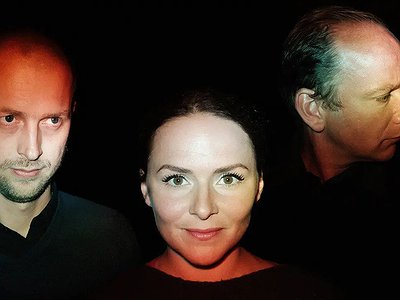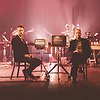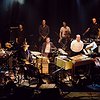Can you talk about a breakthrough work, event or performance in your career?
Aarich: At the moment, every step we take with The Colorist Orchestra feels like a breakthrough. The concerts, the recordings, composing, inviting artists to collaborate.
Kobe: Agreed
Why does it feel special to you?
Aarich: Because it’s feeding the energy we need to go on and to grow.
When, why and how did you start working on it, what were some of the motivations and ideas behind it?
Aarich: We started with a manifesto where our goal was to conjoin pop music with weird stuff. A pop song would be an excuse to create an arrangement based on sounds and instruments we love to experiment with and search for some different palette of sound.
The collaborations with songwriters and singers are essential. We started five years ago with Sumie Nagano and then we continued with among others Emiliana Torrini, Lisa Hannigan, Gabriel Rios, and now Howe Gelb. We are motivated when we think there can be beauty in adding our world to the world of the invité.
There are many descriptions of the ideal state of mind for being creative. What is it like for you?
Aarich: It’s when my head starts floating and I’m not sure where it is going. I have to let go of the reins for a while and go into a dreamy mood.
Kobe:There are so many types of status that can add value to inspiration. But depending on the goal, what works today may not be constructive at all tomorrow. It remains mostly work, work and challenging yourself knowing that the great satisfaction comes the moment you can start sharing the result.
What supports this ideal state of mind and what are distractions?
Aarich: Being tired, or early hours of the day are the best conditions to get in this state of mind. A long walk alone can also be very effective.
Kobe: I'm a morning person so a morning walk, a cup of coffee, the dog at my feet, kids off to school, a silent studio, a sun-drenched garden ... doesn't sound bad, keep it coming!
Are there strategies to enter into this state more easily?
Aarich: Going to bed late.
Kobe: Going to sleep early.
Music and sounds can heal, but they can also hurt. Do you personally have experiences with either or both of these?
Aarich: Very often music connects me with the past. If I hear music from when I was a child or when I was on a Holiday, it’s always very nice to make this little time travel just by listening to music.
It can hurt if I hear a song that’s connected to a lost relationship.
Where do you personally see the biggest need and potential for music as a tool for healing?
Aarich: In every private life.
There is a fine line between cultural exchange and appropriation. What are your thoughts on the limits of copying, using cultural signs and symbols and the cultural/social/gender specificity of art?
Aarich: Because there’s a cultural context to all works of art, copying some of these just for aesthetic reasons seems like a dangerous thing to do. But I allow some freedom to take inspiration from other cultures without taking care of the cultural/social/gender specificity of art.
I’m talking about music here, maybe it’s different with forms, colours and symbols, they can be more connected to a specific meaning. In my work, I try to manipulate the elements that might be sampled or based on other music, just to make them my own. So the association is less clear and not of any importance.
For example: I can use a bossa nova rhythm without knowing what the origin of a bossa nova is and what the social or cultural meaning is of a bossa nova. I would just use it for aesthetics.
Our sense of hearing shares intriguing connections to other senses. From your experience, what are some of the most inspiring overlaps between different senses - and what do they tell us about the way our senses work?
Aarich: Our vision is connected to what we hear. If we see a piano player and we hear the sound of a marimba, we would be confused as our brain would connect the sound of the marimba with the piano player. A musical performance is always adding some elements in which we hear the music differently. And so our senses work together to capture the world around us. I’m not sure that this is an answer to your question?
Kobe: Music is often associated with listening, but listening in itself is not easy. Consciously hearing what someone is saying is not easy, nor is actually listening to what is happening in a composition or to the narrative power of a song text. It remains a daily learning experience for me.
I think a lot of people listen in conjunction with extrasensory perception. A combination of being conscious and subconscious that we like to seek out just because of the fact that it is something that is inexplicable and extremely powerful at the same time.
Art can be a purpose in its own right, but it can also directly feed back into everyday life, take on a social and political role and lead to more engagement. Can you describe your approach to art and being an artist?
Aarich: There’s always a question of what the need or the use is of what I’m making. But sometimes the work or the artistic ideas change during the process of making. I don’t want to analyze every idea too much before I start working on it, because it can block you.
I must say that I find it very difficult to produce visual art at this moment. It is adding more material to the world and I don’t know if the world needs more? Music is floating in the air and it just seems to make more sense. The music I’m making can reflect on social or political issues, but I hardly have any need to do so. I’ll guess the listener is making connections that could go in every direction.
I have one social ambition I want to achieve, that is to make happy dance music to connect people and give them a good time. To my ears, the music has to be very eclectic with many influences of all kinds of music.
What can music express about life and death which words alone may not?
Aarich: The range of tones and texture in music is so much wider than one person speaking, so it’s obvious that there’s more communication on different layers at once.
The melodies and phrases in music are often very clear, yet not always defined, so there’s many ways to interpret them. Everybody connects to these in their own way.




